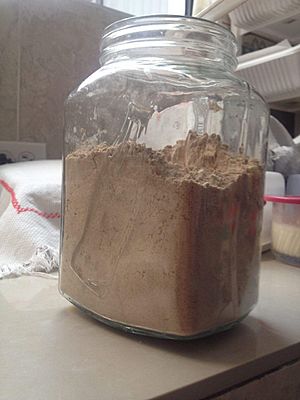Máchica facts for kids
Máchica (pronounced MAH-chee-kah) is a special kind of flour. It comes from grinding grains that have been toasted, like barley. This flour is very popular in the cooking of countries like Bolivia, Ecuador, and Peru. In the Quechua language, it's called machka.
Contents
History of Máchica
Long ago, Spanish settlers brought a special way of preparing grain to the Andes mountains. This method came from Central America. It involved toasting grains to make them more nutritious. Then, they would grind the toasted grain into flour. In Central America, a similar product called pinole was made from toasted corn. But in Ecuador, people mostly used this method for barley.
How Máchica is Made
Making Máchica is quite simple. First, the grain is toasted until it's golden brown. This toasting step gives it a unique flavor and helps with its nutrition. After toasting, the grain is ground into a very fine flour.
Delicious Uses for Máchica
Máchica is used in many different foods and drinks in the Andes region. Here are some examples:
- Chapo: This is a warm drink made with Máchica and herbal tea. People often use lemongrass or lemon verbena for the tea.
- Colada de Máchica: This is another drink. You make it by mixing Máchica with hot or cold liquid.
- Nogadas: These are sweet treats, a bit like nougat. They are made with unrefined cane sugar (called panela), eggs, Máchica, and a type of walnut.
- Pan de Máchica: This is a kind of bread. It's baked using Máchica along with regular flour.
- Pinol: This drink is similar to colada de máchica. It also includes ground panela and spices. Common spices are anise, cinnamon, and cloves.
- Sopa con Máchica: Many different savory soups or stews use Máchica. It helps to make them thicker. These soups usually have carrots, beans, onions, and potatoes. Sometimes they also have meat.
- Torta de Máchica: This is a cake baked using Máchica flour.
Máchica is also used in other ways. People sometimes use it to coat and season meat before frying, like pork rinds or shrimp. It can be added to hot chocolate or cold juice for extra flavor. Some ice cream flavors even use Máchica. In Peru, it's found in stroopwafels, which are cookies filled with Andean ingredients like passion fruit. Some local communities use Máchica to prepare cuy, a traditional meat dish.
Máchica's Nutritional Benefits
Máchica is good for you! It provides energy and important nutrients.
- 100 grams of Máchica made from barley has about 344 calories. It also contains 8.6 grams of protein, which helps build muscles.
- It has 6.6 grams of fiber, which is good for digestion.
- You'll also find important minerals like calcium (74 mg), phosphorus (320 mg), and iron (12.3 mg).
- Máchica from barley also provides vitamins like B1, B2, and niacin, plus 1.9 mg of vitamin C.
- If Máchica is made from wheat, 100 grams has about 347 calories. It also offers protein, fiber, calcium, iron, and vitamin C.
Other Kinds of Máchica
While Máchica is often made from barley, it can come from other grains too.
- In Peru, the Máchica you buy is most often made from toasted corn flour. People mix it with sugar and cinnamon.
- Máchica can also be made from ground toasted wheat. This type is found in Peru and is very common in Bolivia.
See also
 In Spanish: Máchica para niños
In Spanish: Máchica para niños



